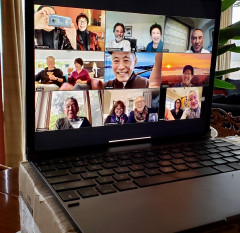Lifestyle Spotlight
The Year of Sheltering Dangerously By Ben Fong-Torres
Avoiding the Winter Blues
Preventive measures to avoid frostbite as the mercury dips below freezing.
Ice skating, skiing, sledding and snowball fights are all fun winter activities. It only takes minutes for exposed skin to become frostbitten in temperatures below 20 degrees Fahrenheit, and winds of 20 miles per hour or more. The American Academy of Orthopaedic Surgeons (AAOS) have a few suggestions for the proper precautions to fight frostbite.
Your body's first priority is to maintain its core temperature when you are out in the cold. To do that, it shifts blood away from the extremities and toward the central organs of the heart and lungs. This increases the risk of cold weather-related injuries, such as superficial or deep frostbite to the arms, hands, legs and feet. With superficial frostbite, only the skin surface is affected, whereas deep frostbite also affects underlying tissues. Body tissue can freeze when it is frostbitten. Ice crystals form in the tissue cells, which can cause physical damage and permanent change in cell chemistry. When the ice eventually thaws from the body tissue, additional changes in the cell may occur, resulting in infection or cell death (gangrene).
"Since it's easier to prevent frostbite than treat it, it is critical to dress properly for the weather and go inside if you are wet or in the cold too long," said Richard F. Kyle, MD, first vice president of AAOS. "If you believe you or someone you are with has frostbite, it is crucial to seek proper medical attention so the injury does not worsen."
Signs and symptoms of frostbite include: numbness and/or loss of feeling in affected area; uncontrollable shivering followed by lack of shivering; loss of physical coordination and speaking difficulties, such as slurring. Skin may swell and blister or appear cold, hard and white. Facial skin may turn grey or blue.
People with frostbite often suffer from hypothermia -- when your core body temperature drops -- which requires emergency medical assistance. If medical care is not readily available, follow AAOS' do's and don'ts concerning first- aid for frostbite:
DO get the person into a warm room as soon as possible and call for medical assistance. You can also give the person warm drinks, such as broth or tea.
DO rest the injured areas (avoid walking on frostbitten feet, for example) and elevate them slightly.
DO take off any wet or restrictive clothing.
DO warm the area by immersing it in warm (NOT HOT) water for at least 30 to 45 minutes, or until the affected part feels warm and sensation returns. During warming, the patient may complain of severe pain and the injured area may swell and change color.
DO NOT do anything that will further injure the tissue. Leave blisters intact, and cover them with sterile, clean cloths.
DO NOT rub the area with your hands, snow or anything else.
DO NOT warm the affected area if there is any chance that it will be exposed to the cold again.
DO NOT use dry heat -- such as from a hair dryer, heating pad, sunlamp, fire, or radiator -- to try to warm the area. Because the skin is numb and will not feel the heat, it can easily be burned by dry heat.
Precautions to brave the bitter cold:
1. Dress appropriately. Light, loose, layered clothing provides both ventilation and insulation. Wear fabric that is water-repellent (not waterproof).
2. Don't forget to protect your head, hands and feet. Substantial heat loss occurs through the scalp, so head coverings are vital. Mittens are warmer than gloves and two pairs of socks (wool over lightweight cotton) will help keep your feet warm.
3. If you plan on being out in the cold for a prolonged period of time, don't drink or smoke. Alcohol, caffeine and nicotine leave the skin more prone to thermal injury.
4. If you get wet, go inside! Remove wet clothing as quickly as possible.
5. Check yourself every 30 minutes or so for signs of frostbite. If your toes, fingers, ears or other body parts feel numb, go inside.
Forprevention information on frostbite, check out Your Orthopaedic Connection ( http://www.orthoinfo.org/ ), or call the Public Service line at 800-824-BONES. With 28,000 members, the American Academy of Orthopaedic Surgeons ( http://www.aaos.org/ ) or ( http://www.orthoinfo.org/ ), is a not-for-profit organization that provides education programs for orthopaedic surgeons, allied health professionals and the public. An advocate for improved patient care, the Academy is participating in the Bone and Joint Decade ( http://www.usbjd.org/ ), the global initiative in the years 2002-2011 to raise awareness of musculoskeletal health to stimulate research and improve people's quality of life. President Bush has declared the years 2002-2011 National Bone and Joint Decade in support of these objectives.
Source: American Academy of Orthopaedic Surgeons
Web site: http://www.orthoinfo.org/
http://www.usbjd.org/
http://www.aaos.org/


